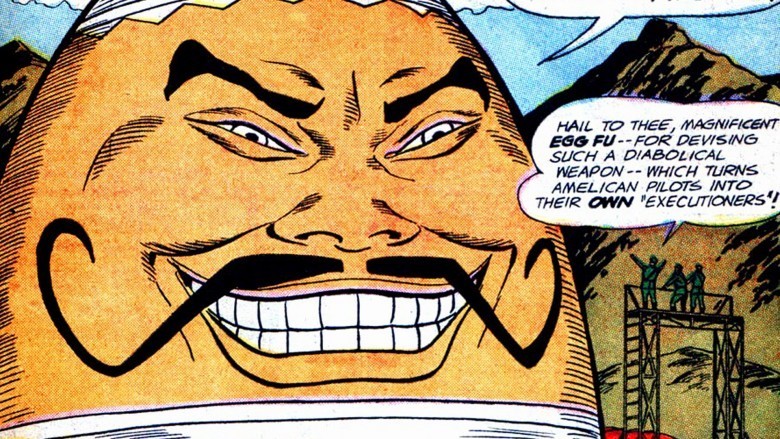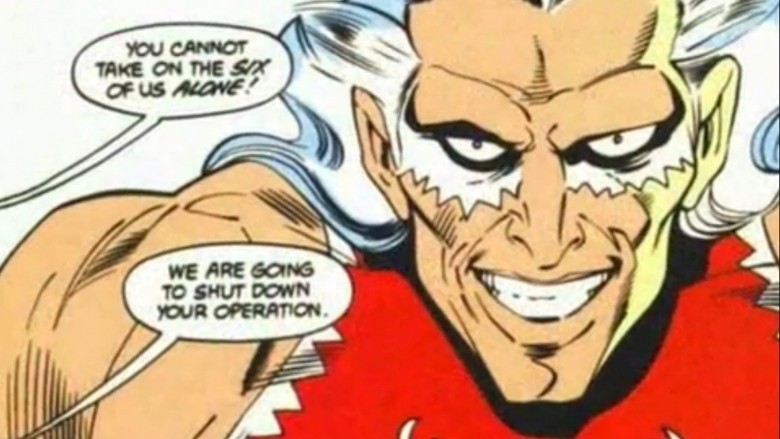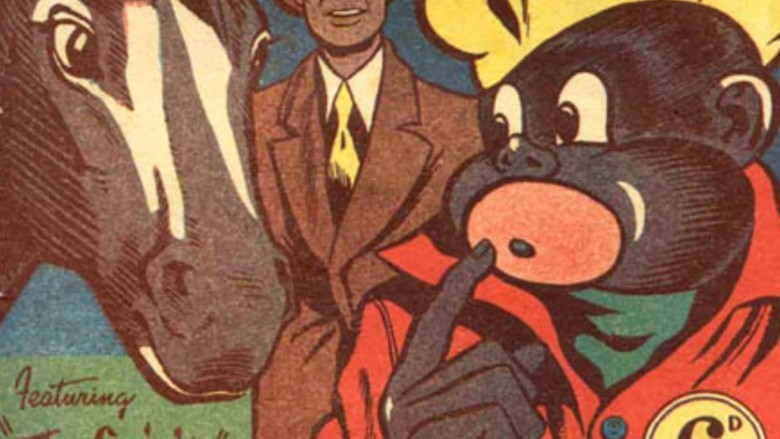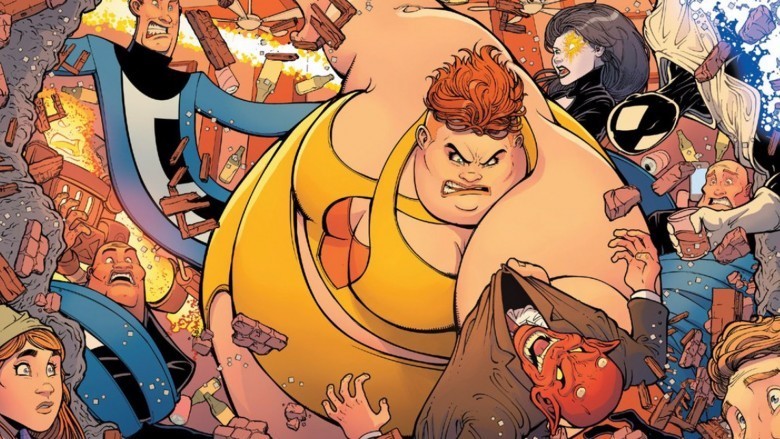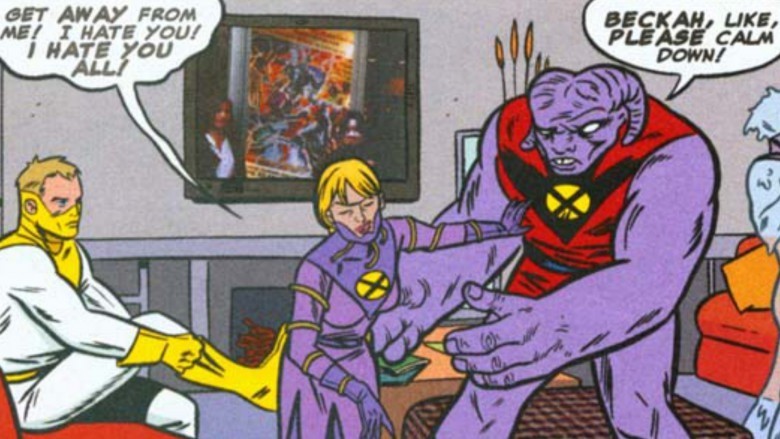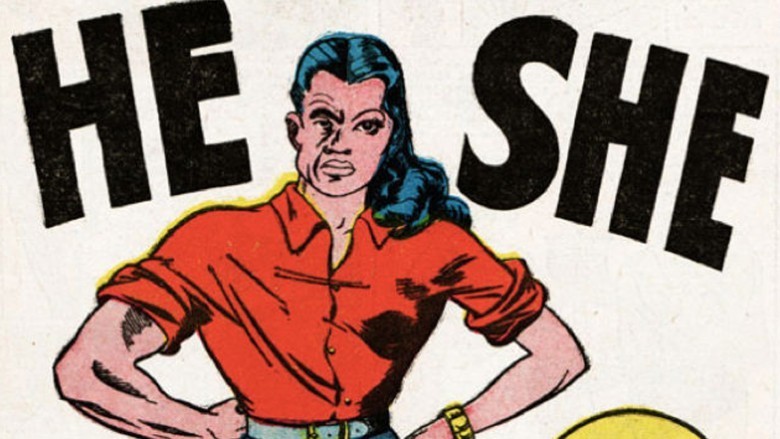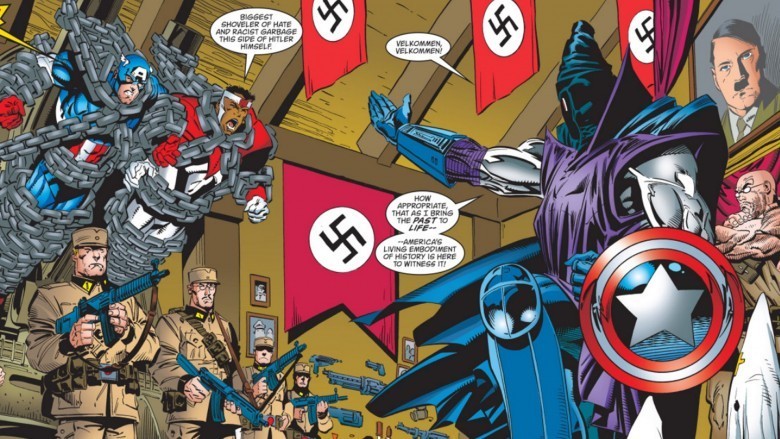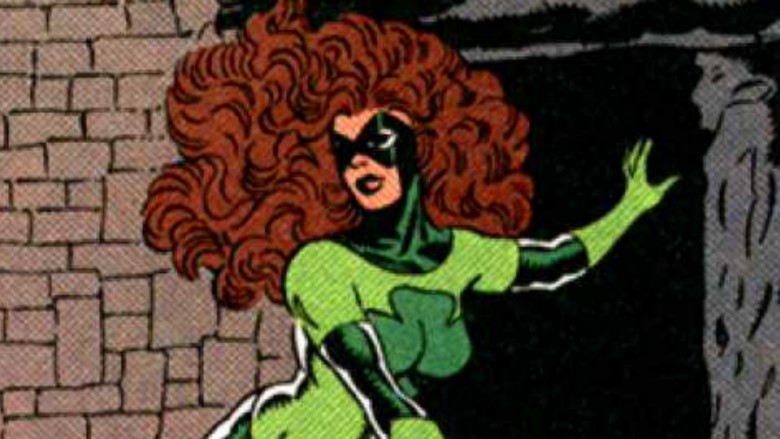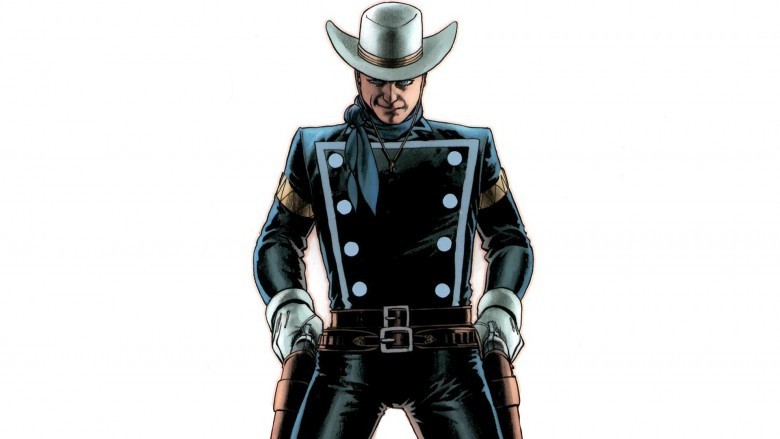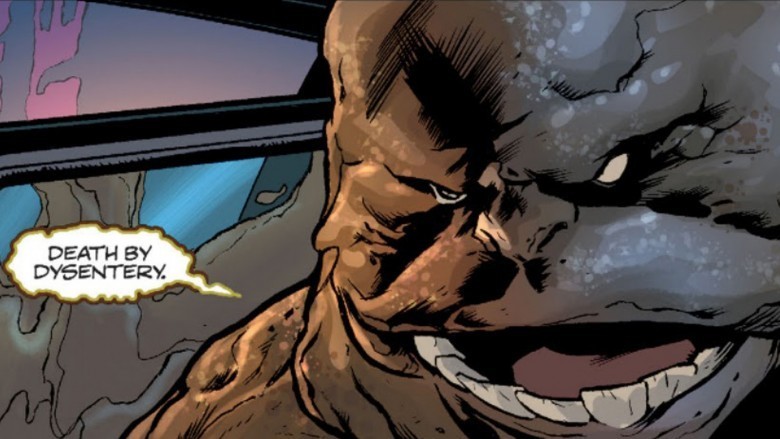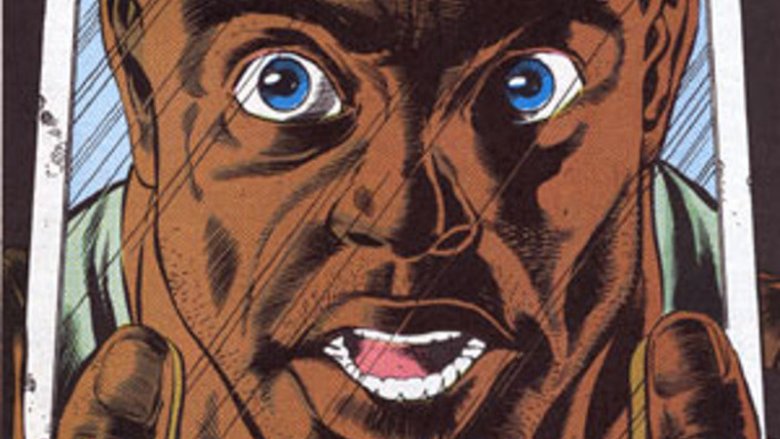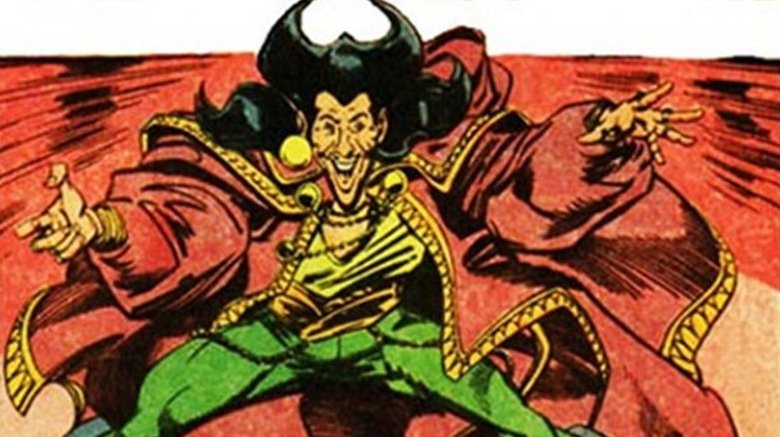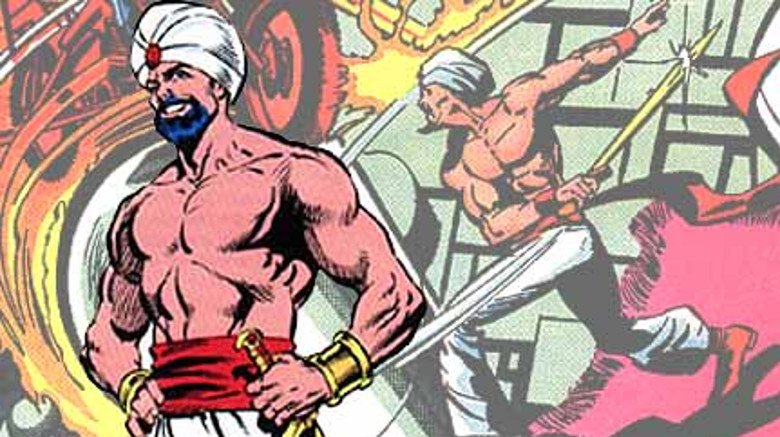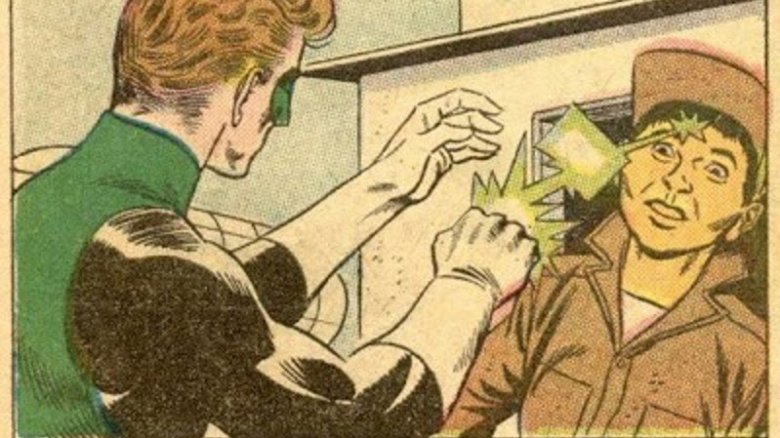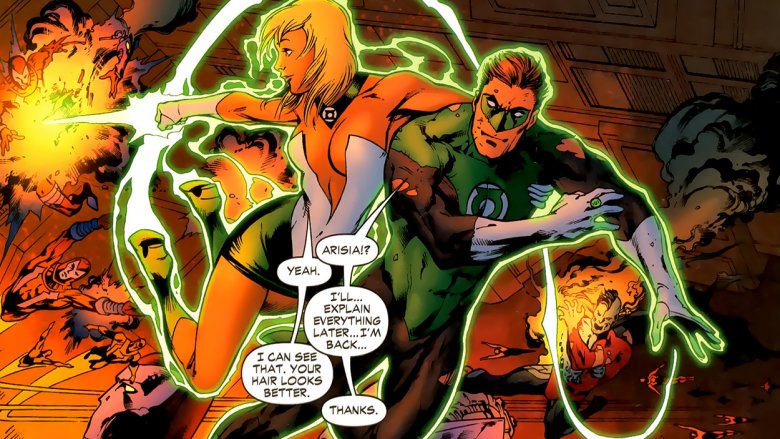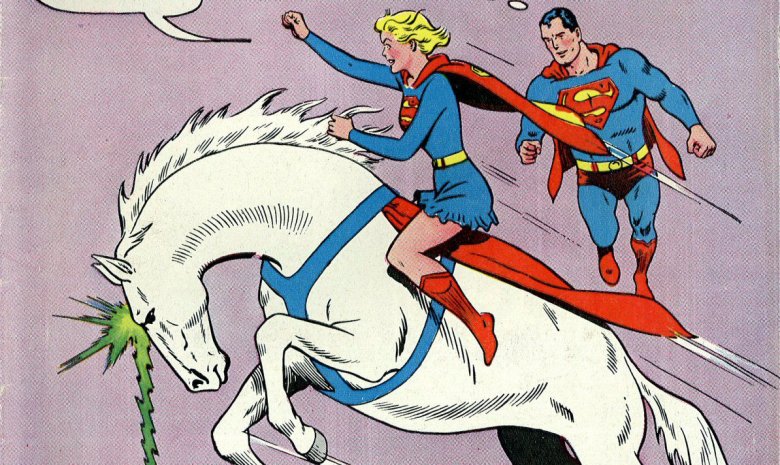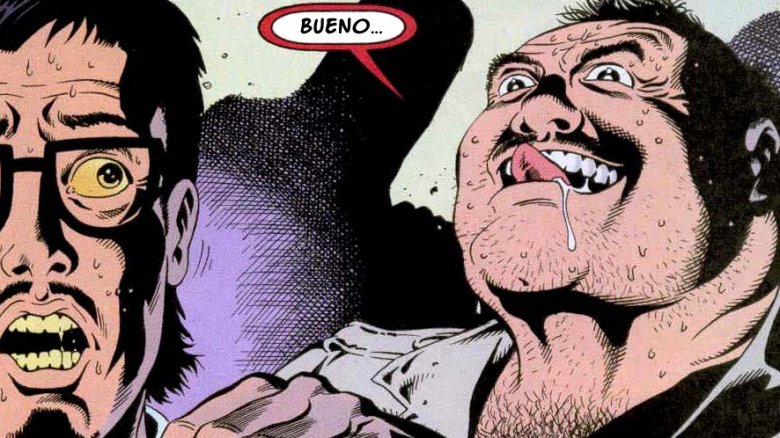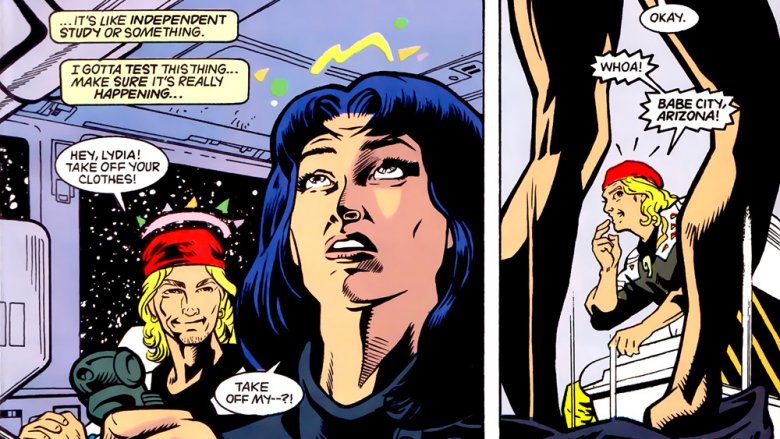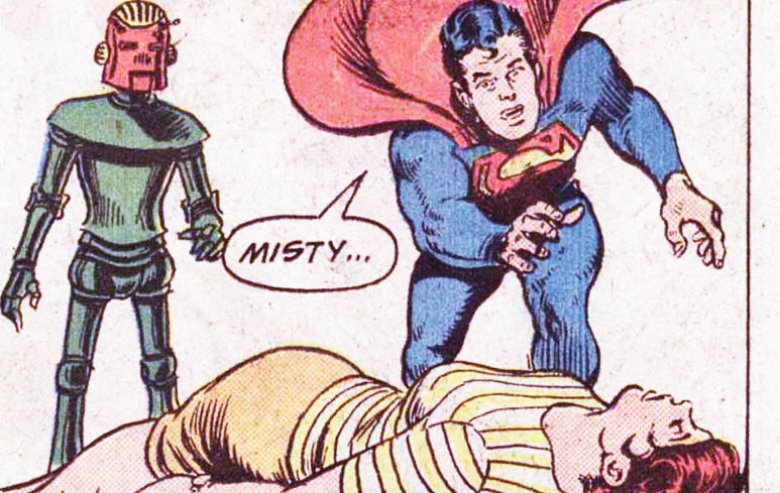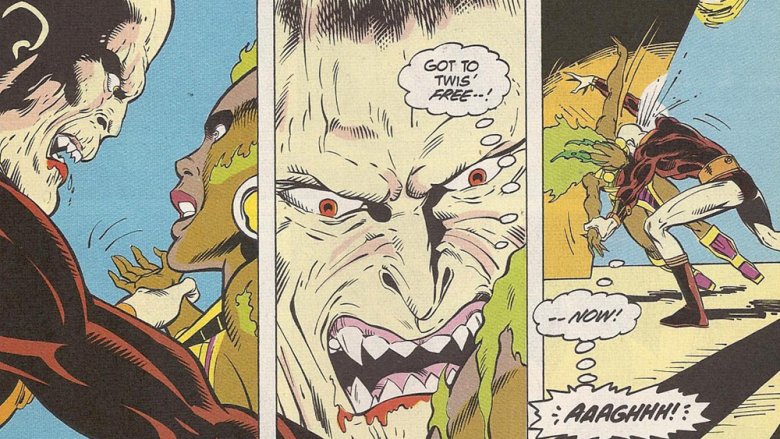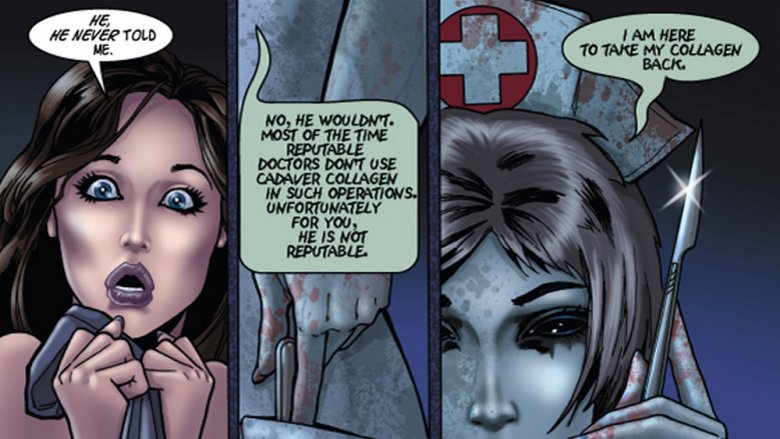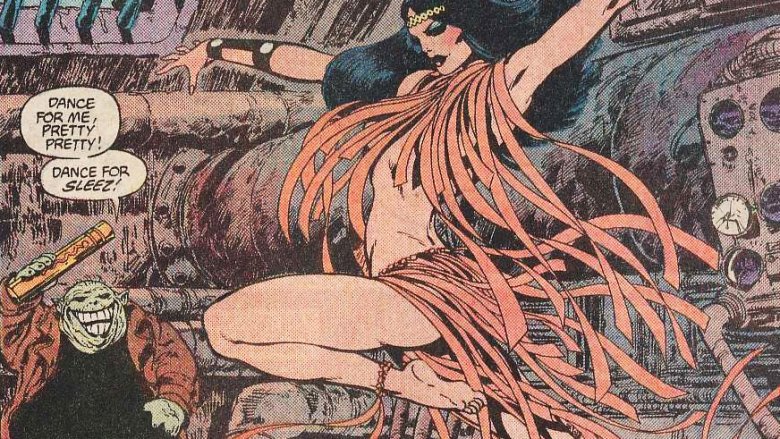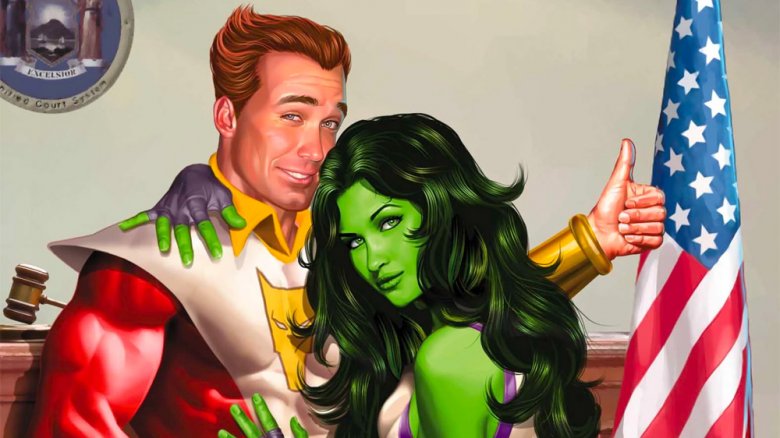Most Inappropriate Comic Book Characters Ever
For every Spider-Man or Superman, there are hundreds of comic book characters you have never heard of. While many of these just didn't hit the market and impress readers, leading to their inevitable demise and relegation to the 10-For-a-Dollar box, some were so incredibly racist, misogynist, or culturally and ethnically insensitive they stood out as examples of what not to do when creating comics.
Egg Fu
Egg Fu was created back in 1965 for an appearance in Wonder Woman #157, and he hit every single Asian stereotype that could possibly be attributed to an egg-shaped bad guy. His face looks like one of those propaganda posters about the Japanese during World War II, he has the requisite Fu Manchu mustache, and he spoke in an accent undeniably racist: "The foolish Amelicans do not know that the instant any of their pilots attempt to take photoglaphs of our installations — they might just as well pless a tligger against their own blains!"
The backstory for this offensive character is that he was a Chinese Communist agent who, for some unexplained reason, was the size of a house and shaped like an egg. Oh, and that Fu Manchu he was sporting — well, that thing was prehensile. It acted as his arms, allowing him to whip and grab his enemies ... because, y'know, he was an egg without actual arms, so what else was he going to do?
Throughout his publication history, he continued to offend just about anyone with the sense to take offense. He has been retconned and reimagined over the years, but little could be done to forget his offensive beginnings. He even became enamored with Wonder Woman's body at one point and attempted to seduce her. You know, that old chestnut. His modern adaptation is less offensive in obvious ways, but still hints at various cultural stereotypes that are better left on the wrong side of history. Not only is this character offensive to about 2 billion people on the planet, he's also offensive to eggs. That's gotta be a new low.
Snowflame
Snowflame has to be one of the weirdest characters to ever grace a comic book page. On the surface, he's just this guy with super stamina, strength, and something called Blast Power. A regular, run of the mill, super-powered ... wait ... oh, he gets his powers from snorting cocaine. You read that correctly! Snowflame has only ever appeared in one comic book: The New Guardians #2 in 1988. This was during the so-called War on Drugs, and comics were doing their part to show just how dangerous something like cocaine could be. So maybe a leader of a drug cartel attaining superpowers from snorting cocaine wasn't the best idea?
In the issue, he first fights the New Guardians and then gets thrown into a shed, which explodes. In most cases, this would be nothing but a flesh wound or light hazing, but in Snowflame's case, he really did appear to be dead. Take a lesson from that, kids: drugs kill ... and give you superpowers, but we are keeping that part on the down-low.
You might think that Snowflame's tale began and ended in that one issue, but you would be wrong about that, thanks to one highly devoted and talented fan. Snowflame's adventures continued on the fansite snowflamecomic.com, where you can follow in his coke-snorting adventures as he woos chicks and kicks superhero butt. The webcomic is drawn very well by artist and writer Julie Sydor, and the story is captivating and thoughtful. It's amazing what a talented fan can do with some time on her hands and an interest in a coke-snorting sociopath who only appeared in one comic almost 30 years ago.
Ebony White
Ebony White is one of the most racist depictions of black people to ever appear in comics. This really is a "Just look at him" sort of situation. He is drawn with disturbingly-large lips (seriously, they took up about 50% of his face) and eyes, spoke in a heavy accent, and looked pretty much like, well, a horrendously racist depiction of a black person when he was first printed in The Spirit #2 in June 1940. Ebony was the sidekick of the titular superhero crime fighter and lived with him in Wildwood Cemetery. Creator Will Eisner took a lot of heat over the character — people even complained about the racist depiction in the 1940s, which is saying something, considering the civil rights movement famously didn't gain much momentum until the 1960s. After receiving numerous letters of complaint, Eisner sent Ebony off to school in 1946, but he continued to appear in the series looking pretty much the same for years.
Fortunately, the character was redesigned when he was brought back into publication for modern audiences. Today's depiction of Ebony looks like a regular human being, with no exaggerated features. He still partners with The Spirit, working as his getaway driver and sidekick. Eisner took a lot of flak over the years for his character, but always stood by him. He even acknowledged his use of stereotypes, but remained unapologetic, even saying, "The only excuse I have for [that portrayal] is that at the time humor consisted in our society of bad English and physical difference in identity." It could be said that Ebony White was a product of the time in which he was created, but that really doesn't excuse the outright racism brought to light in the pages of The Spirit.
Big Bertha
It's hard to say whether or not Big Bertha is a commentary on the problems within the fashion industry or the social stigma of being extraordinarily overweight. Bertha is representative of both extremes: she's a mutant who can transform her body into 630+ lbs. while possessing the usual superhero buffs (strength, stamina, density, etc.), but she normally looks like a sexy and thin supermodel named Ashley Crawford. Her wealth from modeling helps to fund the Great Lakes Avengers, where she works as one of the team members. Her being a super-hot model one minute and a massively overweight superhero the next isn't exactly inappropriate — it's her path from fat to thin that's just plain wrong.
She literally purges the fat from her body to reduce back to the fit, model body she normally possesses. Does that sound anything like bulimia to you? The last thing comics should be teaching young women is that they can puke out their fat to become hot, but that's exactly what this character does. In the books, she's a superhero and the most successful supermodel in Milwaukee, Wisconsin (not sure if that's really saying something) and is well-respected among the superhero community, but we just can't shake the awful depiction of a superhero who pukes away her fat whenever she wants to be thin and pretty. She usually walks out of the bathroom wiping her mouth with a huge smile on her face ... like we all do when we puke our guts out. Marvel could have just made her shrink and grow through the magical power of mutation, but they went with the "bulimic supermodel superhero" idea instead. Barf.
Gin Genie
Gin Genie had a pretty impressive superpower: she could create powerful seismic waves equal to the amount of alcohol in her blood. That seems like something you could put to good use, but the character was pretty short-lived in the comics. No, she didn't die of cirrhosis of the liver. Gin Genie was taken out by a helicopter gunship, but would likely have succumbed to a rotten liver sooner or later. Since this lady needed to get loaded in order to become a contributing member of the team, she came with a few more problems than your typical superhero in X-Force. She wasn't just a drunk, she was a mean drunk, which was never a good thing if you happen to have pissed her off recently.
While wasted, Gin Genie would often attack her teammates instead of focusing her drunken might against their enemies. She also tends to cause severe tremors whenever she is detoxing, so it's best to keep her loaded most of the time. You might be wondering why such a character is inappropriate — after all, she just drinks a little a then kicks some hiney. What's so wrong with that?
Well, the X-Force is not just a superhero team, it's a reality show superhero team. Imagine growing up watching Popeye, but instead of eating spinach to gain strength and kick Bluto's butt, he downs a fifth of whiskey, smacks the crap out of Olive Oil, pitches Swee'Pea into oncoming traffic, and then kicks Bluto's butt. Team member U-Go Girl even commented once that being a fan of Gin Genie is similar to posting one's Alcoholics Anonymous records on the internet. Maybe not the best role model for kids who might be tuning in to watch the latest and greatest adventures of the X-Force.
He-She
It's highly unlikely you ever picked up a comic book and read the misadventures of He-She, who had the obviously inappropriate tagline, "The deadliest of the species is the female! The strongest of the species is the male! Combine these with the killer instinct and you have the most cunning, the most vicious, the most fiendish killer of all time!" The character only ever appeared in one comic, Boy Comics #9, published in 1943. He-She is literally half man and half woman, and He-She is somehow able to stand in profile and perfectly mask one side of his/her face, which is how he/she uses her powers of seduction or mighty man-strength against an unwitting enemy.
In his/her one and only adventure, the "He" half cons a landlady into marrying him while his neatly-placed fedora masks his more feminine features. When his peculiar nature is unearthed (the hat came off), he goes into a blind rage and kills his wife, drags her downstairs, and stuffs her body into the wall, Edgar Allen Poe-style. He also wastes her cat with a pitchfork. The reasons for this character being inappropriate are pretty clear. It's not a transvestite or transsexual — that would have been fine. No, it's literally half a man and woman stuck together into a grotesque amalgam of human sexuality. Thanks, but no thanks.
Hate-Monger
Hate-Monger looks like a new inductee to the Ku Klux Klan who skimmed the Evite and went with the purple hood so he would stand out. The character has been a part of mainstream comics looking like that since he first debuted in Fantastic Four #21 in 1963. His main weapon is something called a Hate-Ray — can you guess what it does?
When he was first encountered by the Fantastic Four, Hate-Monger was giving a speech about why we should be intolerant of foreigners and those who don't agree with him. Thing didn't like what he heard, so he smashed the guy's podium to smithereens. That's when the Haterade comes out, along with his handy hate-gun. He uses it on the FF who immediately turn on each other.
Eventually, the FF agree to continue to fight the good fight, even though they hate one another, while Reed goes on the hunt for a cure to the Hate-Ray's effects. They bring in Nick Fury to help out, and in a classic case of "Whoops," Hate-Monger blasts his goons with the ray and they kill him. Our heroes go to unmask the villain only to find out that it is none other than Adolf Hitler! You've probably already heard of that guy.
Not only did Hitler survive the war (and his suicide), it turns out he transferred his consciousness into a clone brain ... or something like that. It's an incredibly convoluted backstory, but the important thing is Hitler was alive in 1963 and he was the Hate-Monger. The character didn't die there and then. His consciousness continued to transfer from one brain to another, prolonging the life of one of the worst human beings to have ever lived.
Shamrock
The character Shamrock is little more than all the stereotypes of the Irish you could imagine, but put into a hot chick who cuts hair and moonlights as a superhero. Her superpower is, of course, luck. She wears green, has red hair, is imbued with a magical aura that grants her good luck, and that's pretty much it. We're not sure why Marvel didn't just go ahead and make a Leprechaun comic character, instead ... oh, never mind. They totally did that, too.
It's unfortunate that the character is so offensive, because her luck power is actually pretty interesting. She is possessed by the spirits of innocent victims who were killed during a time of war. These spirits leave her body and come to her aid whenever she needs it, so the bullet that would have hit her is pushed slightly to the left, for example, or the anvil that would have comically dropped on her head misses her by just a few inches. It may seem like good luck, but it's really just a bunch of poltergeists hooking her up so they can keep hold of their sweet ride.
Rawhide Kid
The Rawhide Kid is one of those really old intellectual properties Marvel had sitting around that they didn't want to lose the rights to, so they decided to bring him back. Originally, he was just another comic book gunslinger who entertained the kids until the space rangers came along and people weren't as interested in western tales anymore. That's why he sat in the drawer for decades, with nobody interested in publishing him. When Marvel finally decided to do something with the character, they changed only one aspect of him — they made him gay. Now a gay cowboy is not in any way inappropriate, of course, but they made him as gay as the day is long and heaped just about every stereotype at the character they could.
He was brought back in 2003 in the series Slap Leather and again in a follow-up called The Sensational Seven. Since they just changed his sexual orientation, the most obvious alteration was to his speech. "You kids are such gossips, aren't you? Okay, here's the rundown: I'm faster than Kid Colt, the Two-Gun Kid, Apache Kid and Kid Shaleen. Also faster than Wyatt Earp who is soooo overrated and rude it makes me crazy to talk about it. As far as the Lone Ranger, all I can say is, I don't care which one of us is faster, I just want to meet him. I think that the mask and the powder blue outfit are fantastic. I can certainly see why that Indian follows him around." Real subtle, Marvel.
Making the guy gay didn't really add very much to the character. He was already well-established, having been printed off and on since 1955 in more than 130 books. No new backstory, no new anything ... they just made him gay. It seemed like they were pandering to try and bring in an audience they had previously ignored, but it just comes off as offensive and unnecessary.
S***head
If the name of this guy didn't already tip you off that he was probably a bit inappropriate for regular audiences, the knowledge of his composition might. Top Cow Comics' S***head is made entirely of human excrement — specifically, the feces of the 666 most evil people who have ever lived. You can probably guess at some of the names: "There's a little Hitler, a touch of Ed Gein, and a half pound of Jeffrey Dahmer." Love the specificity of "half pound," like whatever spawned this thing was using a kitchen scale.
Not only would you not want this guy over to your home for tea stepping on your new carpet, you really wouldn't want him as an enemy, either. You wouldn't want him touching you, much less swatting his s****y arms or legs anywhere in your direction. In addition to being made of crap, he has the ability to control his density or elasticity, alter his size and shape, is super strong, and can heal from most injuries. Folks, it's little more than a walking, talking pile of crap with a nasty attitude.
You might think that were would be no way whatsoever to kill such a monster, but fortunately, that isn't the case. In Wanted #5, he and The Killer face one another. S***head proclaims that he cannot be killed, which is when The Killer grabs some heavy-duty bleach and pours it all over him. He's weakened by the bleach, and The Killer takes this opportunity to literally flush him down the toilet. In the end, that's all it took. One mercy flush and the vilest creature to ever walk the Earth was no more.
Black Punisher
The early '90s were a weird time for Punisher. Writers Mike Baron and Chuck Dixon pitted Frank Castle against flag burners, Middle Eastern terrorists, and other ripped-from-the-headlines (and ripped off from the "action" section of Blockbuster) bad guys. At the same time, Marvel relaunched Luke Cage with a new series, bringing the "Sweet Christmas" blaxploitation-inspired hero into the "New Jack" '90s. To introduce the new version of Cage to readers, Marvel teamed up Luke and Frank Castle in an infamously awkward storyline that found the gun-toting vigilante wearing blackface for several issues.
Issue #59 of The Punisher, dated Jan of 1992, saw Frank Castle undergoing plastic surgery to repair the scars he received from villain Jigsaw while in prison. The woman who performs the surgery, a former doctor turned drug-addicted prostitute, takes Frank's request to make him unrecognizable a bit too literally and changes his skin black through a bizarre melanin procedure. Now going by the name Frank Rook, the Punisher teams up with Luke Cage to take down a crime syndicate. This leads to some heavy-handed social commentary (Frank Rook is beaten by racist cops), dated stereotypes (Cage sports a flattop and says "Boyeeee" a lot), and the usual predictable arguments about Punisher killing every bad guy in his path.
Eventually Frank's new skin color starts to fade (that's not how plastic surgery works, '90s comic book writers), and he turns back into a Caucasian killing machine in an issue titled (heavy sigh) "Fade ... To White." Here's hoping Netflix teams up Luke and Frank on the upcoming Punisher series so we can finally erase this meet-up from our collective memories.
Extrano
While DC Comics has made progress in recent years with positive depictions of gay characters in titles like Batwoman and Midnighter and Apollo, the publisher is also responsible for one of the most offensively stereotypical characters in comics history. Originally appearing in 1998's Millennium series, Extrano is a magician who was part of the New Guardians team of superheroes. Though he never came out as homosexual, Extrano was coded as gay through his flamboyant clothing, larger-than-life personality, and penchant for calling himself "Auntie." (Adding insult to injury, his name means "strange" in Spanish.)
Further proof of this dark time in DC Comics history is the storyline in the short-lived New Guardians series (the same comic that featured the coke-snorting villain Snowflame) that saw Extrano and other members contracting HIV from an AIDS-vampire named ... wait for it ... The Hemo-Goblin.
Recently, writer Steve Orlando updated Extrano for our more enlightened times in his acclaimed Midnighter and Apollo series. Now married and living a peaceful life, Extrano has been finally granted some dignity—and a more flattering hairstyle.
Arabian Knight
Several characters have gone by the name "Arabian Knight" in the Marvel universe, but only one looked like he stepped out of a direct-to-video Aladdin knock-off. First making an appearance in the pages of The Incredible Hulk, Arabian Knight popped up in various Marvel comics during the '80s that found him flying around on a magic carpet, brandishing a scimitar and butting heads with Israeli heroine Sabra.
The character never grew past the generic Muslim warrior/genie stereotype and was grafted onto the Iraqi superhuman team Desert Sword in a 1991 New Mutants comic. The team, which also featured a member named The Veil who secreted chemicals from her skin (because Iraq was synonymous with chemical warfare back in '91) took on the superhero team Freedom Force in a heavy-handed story with real world parallels to the first Gulf War.
A mid '00s version of Arabian Knight lost the Kazaam-style garb, updating the character as a sword-wielding desert soldier. The character hasn't been heard from much lately, which is probably for the best. With the current Ms. Marvel series offering positive depictions of Arab-American culture, it's probably wise for Marvel to put the genie shtick in the bottle once and for all.
Pieface
As seen with the Mandarin or the Egg-Fu, comics has a rich (and unfortunate) history of depicting Asians as otherworldly villains. Another unfortunate stereotype applied to minorities in general is the doting sidekick. Playing Short Round to Green Lantern's Indiana Jones is the character Thomas Kalmaku, an Inuit mechanical engineer who served as Hal Jordan's friend and trusted mechanic. In his early incarnations, Kalmaku went by the unfortunate nickname "Pieface," a racial slur meant to denote "a person with a round face and blank expression."
Making matters worse, Hal Jordan gave Kalmaku the nickname as a play on "Eskimo Pie." (Get it? Because he's of Inuit origin and his face is round? Yeesh.) It's bad enough that "pieface" is something that your racist uncle would say. Did Hal really need to name his trusted companion after a dessert?
In Green Lantern's retconned origin, Hal's racism is toned down, and he defends Kalmaku when a jerky pilot calls his pal "pieface." (Though he still works in a dig at Polish people. Class act, that Hal Jordan.) Kalamaku was even played by Thor: Ragnarok director Taika Waititi in the 2011 Green Lantern movie, which shockingly is one of the character's least embarrassing moments.
Arisia
The DC Universe has played host to a seemingly endless number of Green Lanterns, the outer space police force whose members are armed with Power Rings that can turn their thoughts and willpower into solid objects made of light. With a canon roster that numbers over 7,200, there are plenty of weird ones, from the living planet Mogo all the way to the ultra-'90s badass Jack T. Chance. None of them, however, have been as troubling as Arisia, a Green Lantern who also holds the dubious distinction of being the only superhero we can think of whose uniform wasn't changed at all when it was adapted into a "Sexy Green Lantern" Halloween costume.
That's not really the problem, though — revealing costumes aren't exactly unique among superheroines, and questions about the practicality of miniskirts and go-go boots are pretty pointless when you're talking about an alien armed with a magic wishing ring. The problem with Arisia springs entirely from what she wished for.
In her first appearance, Arisia is a young teenager. After she gets assigned to Earth, her crush on Jordan leads her to subconsciously use the ring to reshape herself into a sexy adult body with a revealing costume. Once that was done, she was free to act on her crush, and while Hal was initially surprised, the two wound up dating for a few years and even living together. The thing is, a teenager who "skipped those teenage years" (as she put it in one issue) is still a teenager and probably shouldn't be dating a guy who was old enough to be going gray.
Comet the Super-Horse
At first glance, it doesn't seem like there's anything wrong with Comet the Super-Horse, one of the superpowered animals who hung around Superman and Supergirl back in the '60s. The thing is, unlike Krypto the Super-Dog, Streaky the Super-Cat, or even Beppo the Super-Monkey, all of whom were superpowered animals from Superman's home planet, Comet isn't from Krypton. In fact, that dude isn't even really a horse.
In reality, Comet is (or at least was) a centaur from Herculean times named Biron, who fell in love with Circe, of The Odyssey fame. Unfortunately, their relationship went sour when she gave him a potion that was meant to turn him fully human that actually turned into a horse instead. To make up for it, Circe used her magic to give him superpowers and make him immortal, but another sorcerer trapped him in space. Now — or, you know, in 1962 — he's a superpowered horse who was freed by Supergirl, and who can only turn human when a specific comet approaches Earth.
So far, all of that is weird, but it's no weirder than anything else that happened in Superman comics in the Silver Age. Until, that is, you get to the story about how Supergirl doesn't know he can turn human, in which Comet takes the identity of a rodeo rider named "Bronco" Bill Starr and dates Supergirl without ever telling her who he is, making out with her until it's time for him to turn back into a horse. Then it was right back to letting Supergirl ride around on his back in a skirt. Super-Horse nothin', this guy's a Super-Creep.
Bueno Excellente
As much as we try to draw a distinction between characters who are inappropriate by accident and those who most definitely cross a line on purpose, a special mention has to be made of Bueno Excellente, a truly disturbing character who "fights evil with the power of perversion." This guy is the definition of inappropriate.
He first appears in the pages of Hitman #18 as a member of Section Eight, a team put together by an alcoholic would-be superhero named Sixpack. His teammates included weirdos like the Defenestrator (a Schwarzenegger-esque tough guy who carried around a window he could throw people through), Friendly Fire (whose energy blasts always hit his own allies), and Dogwelder, who ... well, the name says it all on that one. He welded dogs to people. Look, it's a really weird comic.
Even among them, however, Bueno Excellente stands out. His only "power," such as it is, is to sexually assault other men — including a heavily implied encounter with Kyle Rayner, the Green Lantern of the '90s — while only ever saying the two words that make up his name and chuckling to himself. Amazingly, he's the only member of Section Eight besides Sixpack to survive a battle that wiped out the rest of the team, but his appearances are thankfully few and far between. Considering that he's a walking sexual assault joke, that's definitely for the best.
Jamm
Jamm is the single worst character to come out of DC's 1993 Bloodlines event, and that's saying something. The story ran through 27 different Annuals, with the idea being that every book would introduce a new superhero to the DC Universe, using an alien invasion as the convenient plot device to make it happen. While there were a couple notable exceptions, the vast majority of the characters were along the lines of Gunfire, the man who can turn anything into a gun, or Nightblade, who threw knives, presumably at night.
Jamm appeared in Legion of Super-Heroes, where he literally crawled out of the garbage dumpster in which he belonged to get the power to make anyone do anything he told them to. He was portrayed as an idiotic Bill & Ted-ish skater dude with a backward cap and a hypercolor crop top who leaned on catchphrases like calling things "prodigious" and referring to people he didn't like as "Hoovers." The only saving grace is that everyone else in the comic found him as annoying as the readers did, making it pretty clear that we were supposed to hate this guy.
Not that hating him was difficult. After ordering the Legion to take him to their native timeline of the 31st Century, he tested out his powers by ordering women to take off all their clothes. That only stopped when he tried it on a robotic duplicate of Marie Antoinette, who was unaffected and slapped him instead. Fortunately, he only made a couple appearances, but if you're looking for him, you should probably check out that dumpster.
The Super-Teacher From Krypton
When you're a kid reading comics, it's natural to ask a lot of questions about Superman. How does he fly? What's the most he can lift with his super-strength? How did he lose his virginity and was a sasquatch involved? Well, good news if you've been asking that last question because that was answered back in 1976, and yes, Bigfoot was there to see it.
The story involved a girl named Misty moving to Smallville, deducing Superboy's secret identity, and falling in love with him in the process. It's never actually said specifically that Misty and a young Clark Kent go to the bone zone, but to say that it's heavily implied is an understatement. The story is called "Don't Call Me Superboy" — because "after what I've been through, I deserve to be called a man" — and there's even a scene where Ma and Pa Kent remark that Clark's bed hasn't been slept in. Sadly, in a completely unrelated encounter with some sasquatches, Misty is accidentally beaned with a rock, and dies.
Or she seems to. The whole thing turns out to have been orchestrated by the Super-Teacher From Krypton, a robot that Jor-El sent to Earth in order to test his son. The Teacher wanted to make sure Superboy wouldn't lose control and lash out with his powers, even if he was in a state of rage and grief, so it brainwashed Misty, mind-controlled her into falling in love with Superboy, and then arranged for Bigfoot to show up in Smallville. After Superboy passed this completely bonkers "test," the Teacher erased Misty's memory and sent her on her way, leaving Superman traumatized forever.
The Hemo-Goblin
The one thing you have to give to The New Guardians is that it meant well. Unfortunately, its attempts at creating a diverse cast and dealing with the real-world issues of 1988 went bad more often than not, leading to regrettable characters like Extraño and Snowflame. But while Extraño has been redeemed by later portrayals and Snowflame has garnered his own sort of fan base for being one of the most insane concepts ever printed in comics, nobody's in a hurry to bring back the Hemo-Goblin, the AIDS vampire.
His one and only appearance was New Guardians #1, but it's about one more appearance than anyone ever wanted. In that issue, it was revealed that a white supremacist organization had created (or possibly recruited) a racist vampire that they unleashed on the new team of ethnically diverse heroes. The good guys were able to win that conflict by literally beating him to a pulp, but by the end of the issue, it was revealed that his accelerated vampire metabolism had caused him to die of the disease by the time he was taken to a hospital. The worst part? In the fight against the heroes, he'd managed to infect two of them with the disease.
At the time, even getting a mention of AIDS into a superhero comic was revolutionary, and showing protagonists dealing with being HIV-positive was groundbreaking. At the same time, characterizing it as a disease spread by a blood-sucking Nazi vampire who infected the book's extremely flamboyant gay character was ... well, in retrospect it doesn't really hold up.
Samantha Brown
Samantha Brown is unquestionably the most obscure character on this list. She only ever appears on five pages of the independent superhero comic Tarot: Witch of the Black Rose, a title that has more inappropriate characters per issue than anything else on the stands. In that short time, though, she manages to be the subject of one of the most amazing lines of dialogue ever written: "You have to get out of here! Your vagina is haunted!"
It's worth noting that Tarot #53 doesn't actually feature the title character. Instead, it follows her boyfriend, a mostly ineffectual cemetery-based vigilante called the Skeleton Man, and his ex-girlfriend, a ghost named Crypt Chick. In this dubious adventure, they go up against a quintet of ghosts dressed in sexy nurse costumes who are out for vengeance because their body parts were harvested by an evil plastic surgeon. Samantha was the unfortunate subject of a "vaginal rejuvenation" surgery performed with cadaver collagen, hence the haunting of her nethers.
Make no mistake, the hilarity of the line is absolutely intentional — the Skeleton Man's ineptitude and goofy dialogue are a recurring joke in the comic. That said, Samantha ends her five-page tenure by being brutally murdered by the ghosts who then reclaim their stolen body parts, which puts a real strain on the comedy. It's the tonal whiplash that feels so inappropriate here. The extremely quotable dialogue is just a bonus.
Sleez
It's hard to imagine a character who could be less inappropriate than Superman. He's the iconic model of heroism, so upright and moral that a lot of readers consider him to be downright square. He's probably the last superhero you'd expect to wind up filming a sex tape in a sewer with a married woman, but that's exactly what happens in the pages of 1987's Action Comics #593. It's not really his fault, though — the guy responsible for all this is a villain called Sleez. Well, him and writer/artist John Byrne, but let's just stick with the story here.
Sleez was one of the evil New Gods of Apokolips, a malformed creature whose mind control powers were only rivaled by his depraved sensibilities. In this story — one of only three appearances, each of which ends with his apparent death — he uses his powers on Big Barda, a fellow New God and occasional member of the Justice League. He forces her to do some sexy dancing in his sewer lair, and then decides he should take things to the next level by making a full-on adult film, with Superman as Barda's co-star.
Fortunately for everyone concerned (including the readers), Superman's invulnerable moral fiber gave him the ability to resist Sleez's depravity. He and Barda never got past the stage of a lukewarm, passionless makeout session before Mister Miracle — another New God and Justice Leaguer who's also Barda's husband — interrupted and freed them from Sleez's control.
Starfox
Most inappropriate characters don't last long before someone realizes that having a sex-obsessed mind-control teen or a cocaine-powered superhuman is a bad idea. Starfox, on the other hand, is far and away the most long-lasting character on this list, with an allegedly heroic career that's seen him serving as an Avenger on multiple occasions.
On his native Titan — the moon of Saturn that's home to the immortal Eternals — Starfox was known as Eros, and as his name implies, he has the power to induce a euphoric state of pleasure in anyone around him. The result is that with a few words, or even just his presence, he can make anyone ridiculously attracted to him and regard him as their closest friend, usually with benefits. There are, of course, exceptions to this — he once tried to overwhelm a rampaging Hulk "in waves of ... pleasure" and got punched into next week for his trouble — but since he can't turn it off, he's basically just a walking thirst trap who frequently indulges in the results.
The implications of this aren't even subtext, either. In a 2005 story in She-Hulk, Starfox was actually put on trial for multiple cases of sexual assault, and the only defense was that the women he'd slept with had wanted to. The trial never finished, and Starfox was taken back to Titan, but considering that his own defense attorney wound up punting him right in the ol "moons of Saturn" after realizing he used his powers on her back when they were both Avengers, it definitely didn't paint him in the best light. Oh, and also, he's Thanos' brother, meaning the Mad Titan who once killed half the universe is actually not the worst member of the family.
Kaito the Reindeer
Japanese manga has a long history of somewhat inappropriate relationships between, say, immortal 14-year-old princesses and their 21-year-old destined lovers, but none of them have ever gotten as weird — or as festive — as the one depicted in Sweet Rein. It's a Christmas-themed shojou romance comic, but unlike most holiday love stories, this one comes with a helping of submission and shape-shifting.
The basic idea here is that in the world of Sweet Rein, Santa Claus isn't a person. It's more of a job, with the Santas seemingly chosen at random. The trick is that they don't know they're Santas until they meet their Reindeer, at which time an invisible magical leather leash appears around the reindeer's neck to connect them to their Santa. Oh, also, the Reindeer is a person until they're commanded to turn into a Reindeer, and they have to do everything the Santa tells them to.
In this case, the Santa is a 17-year-old girl named Kurumi and her Reindeer is a 17-year-old boy named Kaito who is really, really into the whole master/servant aspect of their relationship. So if you wanted to read a slow burn story about teen Santa eventually falling in love with and making out with a sexy reindeer boy in a master-servant relationship, this is absolutely the comic for you. Also ... why?
